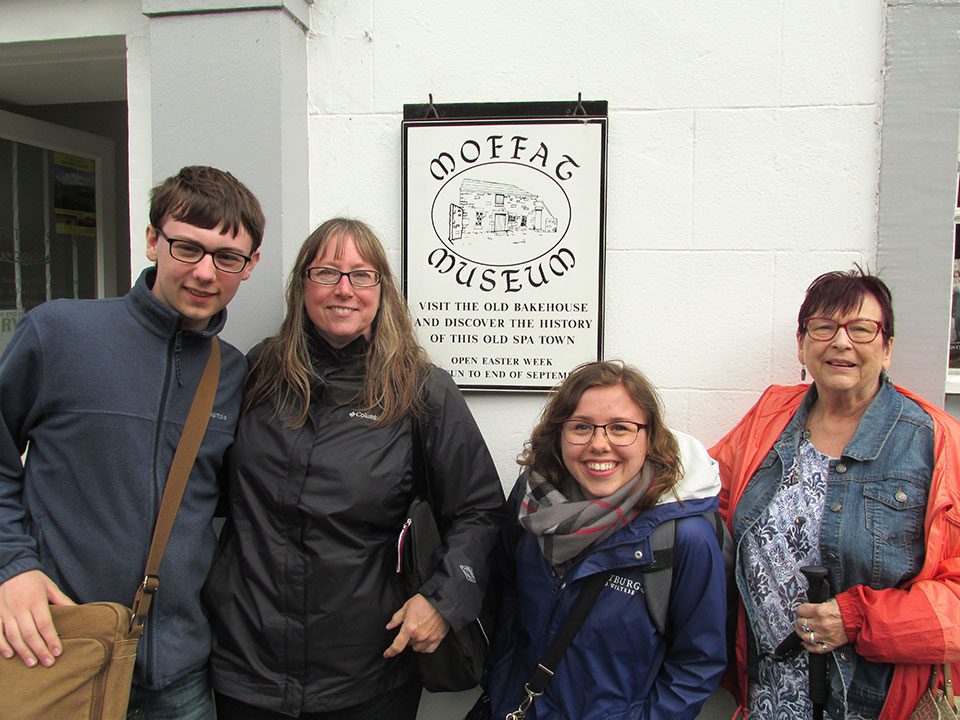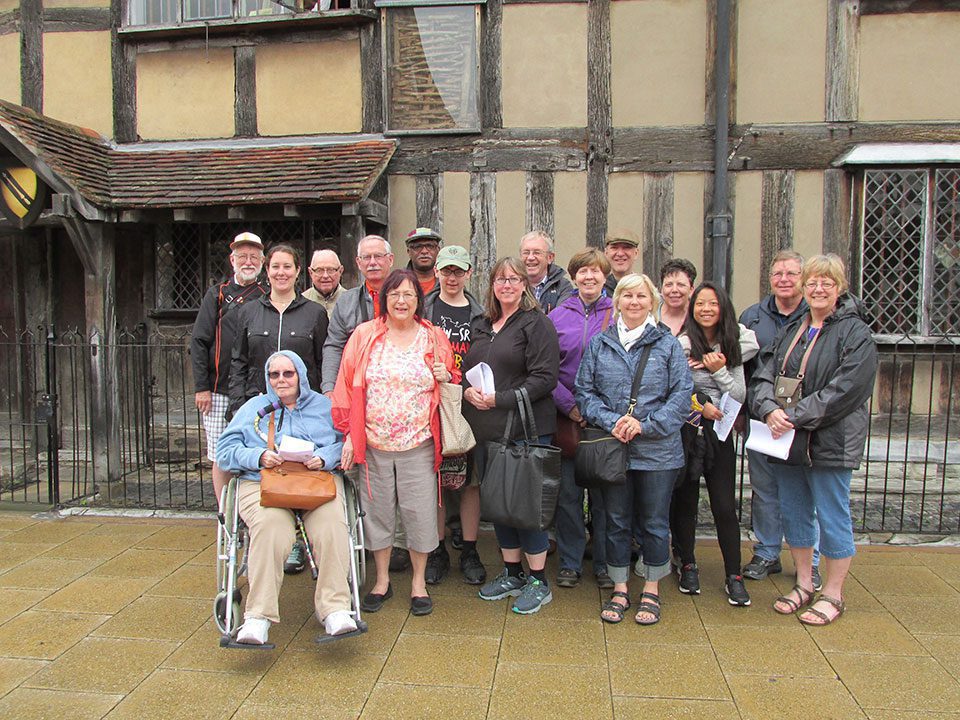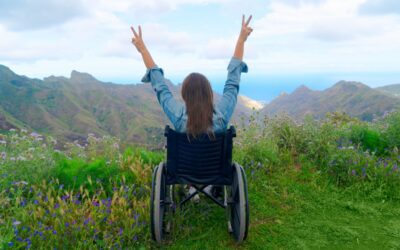Last updated on November 11th, 2024
Tips for Accessible Travel in Europe
by Elizabeth Bingham
Editors note: In 2020, I received an email from Elizabeth Bingham, a travel writer who has written multiple foreign language and culture books for travellers to Europe, as well as two travel memoirs.
Elizabeth had just launched her new book Easy-Walking Europe: Tips and Suggested Tours for the (Somewhat) Mobility Impaired, which is specifically for people who “still get around fine but can’t walk as far or as fast as they used to, and stairs can take a while.” The book features specifics for nine European cities — Edinburgh, Dublin, London, Amsterdam, Paris, Madrid, Rome, Vienna, and Munich — including a detailed sample itinerary and sections on arrival, transportation, sightseeing passes, day trips, lodging, and other base cities.
Elizabeth wrote the book after her mother found herself repeatedly exhausted during a group tour the two were taking in England. When her mom said later that she’d like to visit Scotland next, Bingham researched how to make a visit abroad less taxing and then tested her ideas with people who are no longer as fit or mobile as they used to be, including her mother. Her modified approach to travel worked wonderfully, other people wanted to know how to do it, and thus a new travel book was born.
Below are some of her tips to help women of all ages travel safely and well.
Ten tips to make travel easier
Do you love to travel but you feel a twinge here, maybe a pang there, and those little warnings are giving you second thoughts?
Aches and pains eventually catch up with all of us, even the most enthusiastic traveller. A new travel guide addresses this reality head-on with advice for making a visit to Europe easy and doable for the slower-moving set.
With the world reopening after widespread shutdowns, women want to travel again, including those who aren’t as young or as mobile as they used to be. Here are 10 tips from my latest book to help you make the most of any holiday:
1. First and foremost, plan ahead. Spontaneity has its place, but if you want to snag the most comfortable, convenient options (especially with hotels and pre-booked tours), you need to get in early, particularly during high tourist season. If you are more than somewhat mobility impaired, then it’s even more important that you do your research and plan ahead.
2. Be willing to compromise. You may need to give up a quaint and charming hotel in favour of a modern one with easy accessibility. The area around the train station may not be the romantic quarter you were hoping for, but if it is the hub of city and regional transportation (as is often the case), that weighs heavily in its favour.
3. Lower the bar. There’s nothing wrong with planning your visit around what’s easiest to get to. If you want to see or do particular things despite their difficulty, make sure that the rest of that day is easy, so you have a chance to recuperate. There are no extra tourist points for making things hard.
4. Slow down in general and take breaks. If you push, push, push yourself all the time (even at a slower speed), you’ll have a harder time enjoying what you do. That’s a good point for all visitors, but especially those with physical challenges. Downtime is important. It’s always good to have time to catch your breath when travelling. This can be time in a coffee shop, in your hotel room, in a park, sitting on a tour bus. Most of us benefit from recharging our batteries a bit during the day, but that’s especially so when we have physical limitations.
5. This is, again, true for all travellers, but travel as lightly as you can. Large suitcases are less of a problem if you stay based in one or two hotels, but even then, hauling them from the airport to the hotel and back is never fun. If you plan to travel with your luggage on trains and buses, you will be grateful for every unnecessary pound you left at home.

Elizabeth and her mother (in front, with Elizabeth’s son between them) pose with their tour group before Shakespeare’s family home in Stratford, England.
This tour made them realize that for people with reduced mobility or stamina, typical guided tours can be too physically demanding for comfort.
- If you take the train, look into ordering tickets online ahead of time. You can usually save considerably on train fare if you book early. You will also know exactly where your reserved seat is and can save yourself wandering through the train cars looking for open seats. In addition, by ordering in advance, you can secure yourself a place on popular trains, where seats can sell out.
- Consider packing a collapsible walking stick or hiking pole for additional support and stability on the inevitable stairs and inclines (and cobblestones!). A $25 investment could save your knees and help you get through the day more easily. Just make sure that the smallest-size pole will fit in your checked luggage, to make sure you’ll be able to transport it easily. Of course, if you use it to get on the plane itself, a flight attendant will probably find a home for it during the flight, but check with your airline’s rules before relying on that. If you use trekking poles that have a sharp metal point under a rubber cover, the poles may need to go in checked luggage.
- If standing (say, during a city tour or while waiting for the bus) exhausts or pains you, you may want to pack a collapsible 3-legged stool in your day bag. Some collapse up to only 15 inches long and weigh less than 2 pounds (while supporting hundreds of pounds). A company called Walkstool, for example, offers various collapsible models with telescoping legs. Check the sitting height before buying, to make sure it’s not a camping chair that you essentially squat in and may struggle to stand up from. (For comparison, a standard dining chair seat is around 18 inches from the floor.) Also look at maximum supportable weight, of course. You probably can’t use a collapsible stool everywhere, such as when touring a palace, but one could ward off pain and exhaustion outside, at least, if standing in place is a problem for you.
- You may already be a packing cube convert, or perhaps you’ve never even heard of them, but they can be a traveller’s best friend. Packing cubes aren’t actually cube-shaped, but they are squared-off zippered bags of various sizes helpful for organizing items in your luggage. Some people use them to compress their clothes into a carry-on and avoid checking bags entirely, but they are also helpful for organizing a checked bag.
- There’s a good chance that your hotel room (small European rooms, after all) will not have a dresser or even shelves and you will have to live out of your suitcase during your stay. Packing cubes can help out here, too. They can serve rather like dresser drawers, keeping all your shirts together, your pants together, socks and underwear, etc. If kneeling next to your suitcase is a problem, you can snag the bags you want and use them at bed level. Using packing cubes really does work well to keep items compartmentalized and prevent them from getting all mixed up in your suitcase, and they could save your knees some wear and tear, as well.

Elizabeth stands with her mother and children in front of the museum in Moffat, Scotland, where their Scottish ancestors were based.
(You can see that her mother has a hiking pole in her hand, which helped her considerably on this trip.)
More Resources
Elizabeth includes links to helpful Web sites throughout the book, including resources specifically for accessible travel. Here are some of her favourites:
- For general travel with disabilities in Europe (including accessible hotels)— Sage Traveling
- For guided tours, with an option to select “Trip Type” according to physical level (including “very easy”) — Travel Stride
- For hotel searches, with a filter for “Wheelchair access” under “Amenities — Trip Advisor
- For lightweight, collapsible stools —Walkstool (on Amazon)
- Find Elizabeth on Facebook
- Find Elizabeth’s Facebook travel page here.
More on Accessible Travel
Making International Headlines: Can Three Women Travel Solo in Wheelchairs to Egypt?
When three women travel to Egypt in a wheelchair, it’s not just about breaking stereotypes about disabilities but also a test of our friendship and support for each other.
Creating an Inclusive Travel World Where Everyone Belongs: Seven Things That Need to Change
With the growing demand for accessibility in the travel space, here are seven ways the travel industry can embrace a higher level of inclusion.
Accessible Adventures in Albania: An Off-Season Road Trip is Full of Surprises
A off-season road trip through the southern part of Albania showcases stunning coastal villages, ancient ruins, and picturesque landscapes.







I am a big fan of Journeywoman over a decade or so. And I have also moved on from intrepid solo traveller, to escorted trips , all inspired by your experienced suggestions and commentaries. Not sure anout my future traveller status, approaching 80, I was thrilled to read the article by Elizabeth Bingham with useful tips for mobility and comfort of the „mature“ traveller. Thank you, you put a spring into my traveller‘s step. Now we all hope that in the near future the Covid virus will be beaten and the world borders will open again for travelling.
In the meantime thanks to Journey woman to keep the dream alive,
Cheers
Gisela Kuepper
Carolyn you heard me!!! This article about slowing down travel is full of things I need to digest. I will get Elizabeth Bingham’s book forthwith. I have been a journey woman for many, many years and benefitted so many times. Now I am 82 but still would like to do some gentle trips, when the embargo is lifted. Many thanks
Great suggestions. I’m almost 78 and travel to European cities and do daytrips from them. I rarely go with tour groups and prefer to travel solo or sometimes with my daughter. Traveling solo allows me to set my own pace and do what I want to do. Am a history and art buff so think nothing of spending an entire day at an art museum or historic site. I planned to return to London this September – I go every second year and visit other cities in the intervening years. Of course, that’s not possible with the virus. I’m hoping to go to London in September 2021 but who knows. I worry if by than I’ll have lost my zest for solo travel, navigating airports, etc. since I’ll be getting close to 80.
London is gradually re-opening with social distancing and hand hygiene in place. Face coverings are compulsory in shops and on buses. Pubs and restaurants are opening. You will never again see London so free of crowds. Museums and galleries have booking systems in place. Theatres are still unable to open safely. I suggest exploring the river bus routes between Greenwich and Hampton Court, parks, theSouth Bank and the “villages” of London including Hampstead and Blackheath. Hotels have details of coach trips.
Wonderful! I am a young hearted woman with very bad knees. I have managed to get around with my cane, taking it slow, and doing what I can. I look forward to reading her book to get some additional ideas.
As someone who has been in 3 rear-endings and now has as many herniated discs that act up … I remember something Gary Lauten, who won the Stephen Leacock Medal for Humour in 1984, said about driving in Toronto … ‘red lights signal 3 more cars can go through the intersection – really really really fast’ – no joke and ouch!
And to this article and book and to capsule travel wardrobes in packing cubes and walking sticks and stools and slow travel, YES!
I am looking forward to reading this book. Thanks for this Journeywoman book discount, too.
this is such useful information. When young I roamed the world, now with a painful hip I think twice but still want to go to Scotland again (where I was married). So the suggestions have given me new hope. Thanks so much. I live in New Zealand. I lived in Iceland for a couple of years a long time ago now.
I can also recommend if you have several large bags and only need one for a few days at hotel, we often leave most of our luggage in train station lockers (where available- check in advance), and take only what what we need. It doesn’t cost much, and gives us much more flexibility on long trips, which we we frequently do by rail pass in Europe. I have fibromyalgia, and have found this to be a lifesaver throughout all of Europe and the UK.
I can also suggest to ask for “wheelchair” assistance when booking your plane ticket. Airports in major cities involve a lot of walking. This will also help you get through customs a lot faster and the worker will know the airport better than you. It’s a free service but a tip is always appreciated.
Airlines offer wheelchair transportation within airports. A godsend in large airports that require walking long distances when transferring planes and even for boarding or getting out of an airport. They take you through interesting “behind the scenes” passageways and put you at the front of the line for boarding. Book this free service when you book your ticket. Tips are sometimes accepted and sometimes declined by the people who transport you. I used this service during my last trip just before the Covid lockdown and was very grateful for the help.